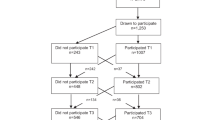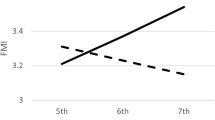Abstract
Background
This study investigates the cross-sectional and prospective associations between accelerometer-measured sedentary behavior and body composition from adolescence to early adulthood.
Methods
Data from the Santiago Longitudinal Study were analyzed (n = 212). Sedentary time was measured at age 16 years, and body composition (body mass index [BMI], waist circumference, waist-to-height ratio [WHtR], fat mass percentage, and lean mass percentage) was examined at both age 16 and 23 years. Adjusted linear regression models estimated associations between sedentary time, sedentary bout duration, and body composition, overall and by sex.
Results
In all analyses, mean sedentary bout duration was not associated with body composition. In cross-sectional analyses, more sedentary time during adolescence was significantly associated with lower BMI, waist circumference, WHtR, fat mass percentage, and higher lean mass percentage (p < 0.05). One standard deviation increase in daily sedentary time was prospectively associated with lower body mass index (β = −1.22 kg/m2, 95% CI: −2.02, −0.42), waist circumference (β = −2.39 cm, 95% CI: −4.03, −0.75), and WHtR (β = −0.014, 95% CI: −0.024, −0.004). Sedentary time at 16 years was not associated with changes in body composition from 16 to 23 years.
Conclusions
Sedentary behavior in adolescence is not adversely associated with body composition profiles in early adulthood.
Impact
-
Little is known about the effect of device-measured sedentary behavior on body composition during the transition from adolescence to early adulthood.
-
Among participants in the Santiago Longitudinal Study, more accelerometer-measured sedentary time during adolescence was associated with lower BMI, waist circumference, and waist-to-height ratio in early adulthood though point estimates were generally small in magnitude.
-
Sedentary behavior in adolescence was not detrimentally associated with healthy body composition profiles in early adulthood. Public health interventions aimed at reducing obesity rates could consider other behaviors, such as physical activity and healthy diet, instead of sitting time.
This is a preview of subscription content, access via your institution
Access options
Subscribe to this journal
Receive 14 print issues and online access
$259.00 per year
only $18.50 per issue
Buy this article
- Purchase on Springer Link
- Instant access to full article PDF
Prices may be subject to local taxes which are calculated during checkout
Similar content being viewed by others
Data availability
The datasets analyzed during the current study are available from the corresponding author on reasonable request.
References
Abarca-Gómez, L. et al. Worldwide trends in body-mass index, underweight, overweight, and obesity from 1975 to 2016: a pooled analysis of 2416 population-based measurement studies in 128·9 million children, adolescents, and adults. Lancet 390, 2627–2642 (2017).
2018 Physical Activity Guidelines Advisory Committee. 2018 Physical Activity Guidelines Advisory Committee Scientific Report (U.S. Department of Health and Human Services, 2018).
Carson, V. et al. Systematic review of sedentary behaviour and health indicators in school-aged children and youth: an update. Appl. Physiol. Nutr. Metab. 41(Suppl. 3), S240–S265 (2016).
Biddle, S. J. H., Bengoechea, E. G. & Wiesner, G. Sedentary behaviour and adiposity in youth: a systematic review of reviews and analysis of causality. Int. J. Behav. Nutr. Phys. Act. 14, 43 (2017).
Barnett, T. A. et al. Sedentary behaviors in today’s youth: approaches to the prevention and management of childhood obesity: a Scientific Statement from the American Heart Association. Circulation 138, e142–e159 (2018).
Tremblay, M. S. et al. Sedentary Behavior Research Network (SBRN) – Terminology Consensus Project process and outcome. Int. J. Behav. Nutr. Phys. Act. 14, 75 (2017).
Chastin, S. F. M. et al. Systematic comparative validation of self-report measures of sedentary time against an objective measure of postural sitting (activPAL). Int. J. Behav. Nutr. Phys. Act. 15, 21 (2018).
Lee, I. M. & Shiroma, E. J. Using accelerometers to measure physical activity in large-scale epidemiological studies: issues and challenges. Br. J. Sports Med. 48, 197–201 (2014).
Young, D. R. et al. Sedentary behavior and cardiovascular morbidity and mortality: a Science Advisory from the American Heart Association. Circulation 134, e262–e279 (2016).
Gibbs, B. B. et al. Definition, measurement, and health risks associated with sedentary behavior. Med. Sci. Sports Exerc. 47, 1295–1300 (2015).
Cliff, D. P. et al. Objectively measured sedentary behaviour and health and development in children and adolescents: systematic review and meta-analysis. Obes. Rev. 17, 330–344 (2016).
Mitchell, J. A. et al. Time spent in sedentary behavior and changes in childhood BMI: a longitudinal study from ages 9 to 15 years. Int. J. Obes. 37, 54–60 (2013).
Mcconnell-nzunga, J. et al. A 4-yr mixed longitudinal study of health behaviors and fat mass accrual during adolescence and early adulthood. Med. Sci. Sports Exerc. 54, 2178–2187 (2022).
Janz, K. F. et al. Physical activity, not sedentary time, predicts dual-energy X-ray absorptiometry-measured adiposity age 5 to 19 years. Med. Sci. Sports Exerc. 49, 2071–2077 (2017).
Gropper, H. et al. The impact of life events and transitions on physical activity: a scoping review. PLoS ONE 15, e0234794 (2020).
Hochberg, Z. E. & Konner, M. Emerging adulthood, a pre-adult life-history stage. Front. Endocrinol. 10, 918 (2020).
Yang, L. et al. Trends in sedentary behavior among the US population, 2001-2016. JAMA 321, 1587–1597 (2019).
Lozoff, B. et al. Behavioral and developmental effects of preventing iron-deficiency anemia in healthy full-term infants. Pediatrics 112, 846–854 (2003).
Burrows, R. et al. High cardiometabolic risk in healthy Chilean adolescents: associations with anthropometric, biological and lifestyle factors. Public Health Nutr. 19, 486–493 (2016).
Correa-Burrows, P. et al. Resolving early obesity leads to a cardiometabolic profile within normal ranges at 23 years old in a two-decade prospective follow-up study. Sci. Rep. 11, 18927 (2021).
Choi, L. et al. Assessment of Wear/Nonwear Time Classification Algorithms for Triaxial accelerometer. Med. Sci. Sports Exerc. 44, 2009–2016 (2012).
Evenson, K. R. et al. Calibration of two objective measures of physical activity for children. J. Sports Sci. 26, 1557–1565 (2008).
McCarthy, H. D. & Ashwell, M. A study of central fatness using waist-to-height ratios in UK children and adolescents over two decades supports the simple message–‘keep your waist circumference to less than half your height’. Int. J. Obes. 30, 988–992 (2006).
Méndez, H. & de Méndez, C. Estratificación social y biología humana. Arch. Venez. Puer Ped. 49, 93–102 (1986).
Burrows, A. R. et al. Dietary intake and physical activity in school age children. Rev. Med. Chil. 136, 53–63 (2008).
Barone Gibbs, B. et al. Sedentary time, physical activity, and adiposity: cross-sectional and longitudinal associations in CARDIA. Am. J. Prev. Med. 53, 764–771 (2017).
Campbell, S. D. I. et al. Sedentary behavior and body weight and composition in adults: a systematic review and meta-analysis of prospective studies. Sports Med. 48, 585–595 (2018).
Ferrari, G. L. M. et al. Sedentary behavior, physical activity and body composition in adults. Rev. Assoc. Med. Bras. 66, 314–320 (2020).
Silva, B. G. Cd et al. Associations of physical activity and sedentary time with body composition in Brazilian young adults. Sci. Rep. 9, 5444 (2019).
Matthews, C. E. et al. Amount of time spent in sedentary behaviors in the United States, 2003-2004. Am. J. Epidemiol. 167, 875–881 (2008).
Jurado-Fasoli, L. et al. Association between sleep quality and body composition in sedentary middle-aged adults. Medicine 54, 91 (2018).
Park, H. K., Kim, J. & Shim, Y. S. Association between sleep duration and body composition in girls ten to eighteen years of age: a population-based study. Child Obes. 16, 281–290 (2020).
Micklesfield, L. K. et al. Adolescent physical activity, sedentary behavior and sleep in relation to body composition at age 18 years in urban South Africa, Birth-to-Twenty+ Cohort. BMC Pediatr. 21, 30 (2021).
U.S. Department of Health and Human Services. Physical Activity Guidelines for Americans 2nd edn (U.S. Department of Health and Human Services, 2018).
Acknowledgements
The authors have immense gratitude for the volunteers who took part in the Santiago Longitudinal Study. In addition, we thank Dr. Erin Delker for her assistance with the data analysis performed in this study.
Funding
This work was funded by the National Heart, Lung, and Blood Institute (T32HL079891, R01HL088530, 1K01HL129087-01A1) and the National Institute of Child Health and Human Development (R01HD33487, R03HD097295). E.B. acknowledges ANID - MILENIO - NCS2021_013. The funders had no role in the design, conduct, analysis, and decision to publish results from this study.
Author information
Authors and Affiliations
Contributions
E.T.H., S.G., S.M.M., P.E., and E.B. contributed to the conception and design of the study. E.T.H. led the drafting of the manuscript. E.B. and R.B. led the data acquisition, and D.W. led the cleaning of the accelerometer data. P.C.B., C.A., P.P., and S.R. provided expert technical assistance on the Santiago Longitudinal Study. E.B. and S.G. supervised the project. All co-authors participated in the review and writing of the final version of the manuscript and gave final approval of this version to be published.
Corresponding author
Ethics declarations
Competing interests
The authors declare no competing interests.
Ethics approval and consent to participate
All participants provided assent at the adolescent visit (age 16 years) and informed consent at the early adulthood visit (age 23 years).
Additional information
Publisher’s note Springer Nature remains neutral with regard to jurisdictional claims in published maps and institutional affiliations.
Supplementary information
Rights and permissions
Springer Nature or its licensor (e.g. a society or other partner) holds exclusive rights to this article under a publishing agreement with the author(s) or other rightsholder(s); author self-archiving of the accepted manuscript version of this article is solely governed by the terms of such publishing agreement and applicable law.
About this article
Cite this article
Hyde, E.T., Gahagan, S., Martinez, S.M. et al. Adolescent sedentary behavior and body composition in early adulthood: results from a cohort study. Pediatr Res 94, 1209–1215 (2023). https://doi.org/10.1038/s41390-023-02616-z
Received:
Revised:
Accepted:
Published:
Issue Date:
DOI: https://doi.org/10.1038/s41390-023-02616-z



